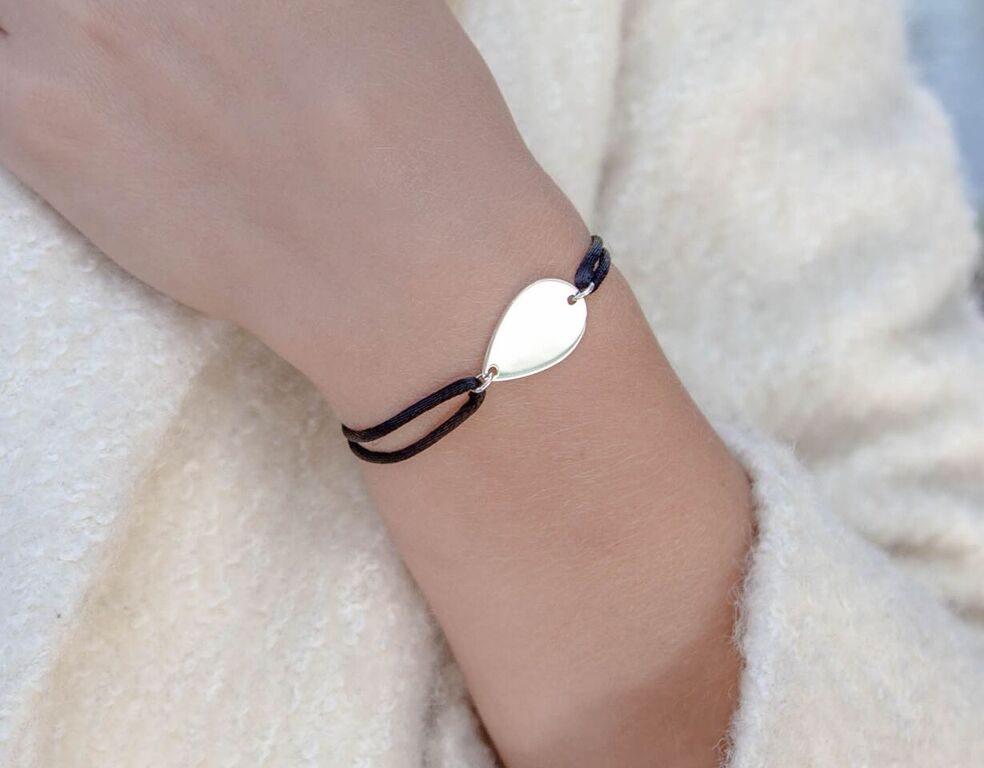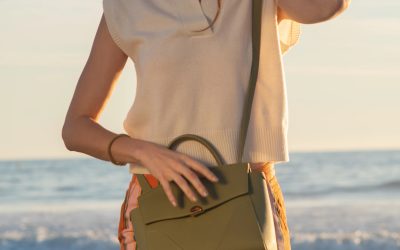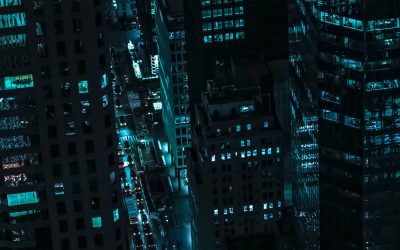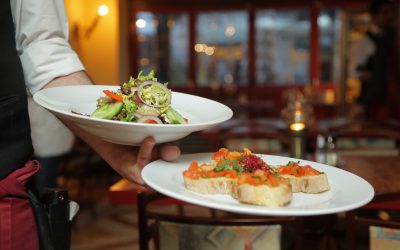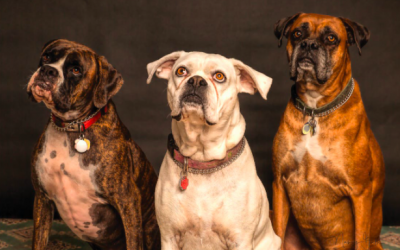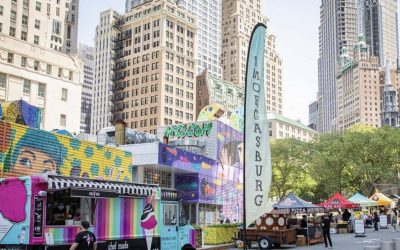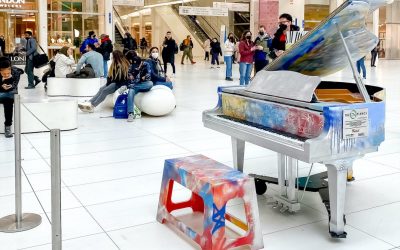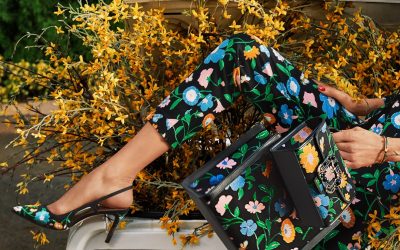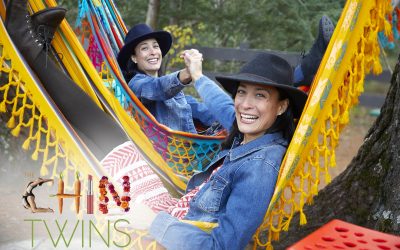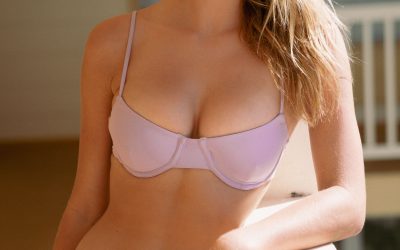As a life-long New Yorker, Nicholas Coblence is a brand strategist by trade and an arts administrator by training. Cords For Music, as founded by Nicholas in 2013, smartly combines his two passions as a socially-motivated fashion brand that benefits the arts. Sales of the music-themed bracelets, earrings and necklaces from Cords For Music – all made in the U.S. — go on to benefit the organization Education Through Music.
This holiday season moves things along further for Cords For Music with the opening of two pop-up stores. Located inside Seaport Studios (19 Fulton St.), one store will be open from Dec. 11 through Jan. 24. Also downtown, the second store is part of Random Acts Of Activity (98 Orchard St.), showcasing from Dec. 8 through Dec. 21.
Nicholas – also a part of Izzygear and Made In Inc., beyond co-chairing the Byrd Hoffman Watermill Foundation’s Byrds Council – kindly tackled some Q&A for Downtown. He opened up about where the Cords For Music idea came up, and also went into depth about the role that music plays in his everyday life. In turn, this was an inspiring interview experience, up through the “last words” he had provided.
For more information on Nicholas and Cords For Music, click on over to www.cordsformusic.com. The site includes artist interviews and playlists beyond links to the merchandise discussed.
Where did the idea for Cords For Music come from?
Nicholas Coblence: It came to me a few years ago when I wanted to start my own business, but didn’t want to veer too far away from giving back, which is something I did formally as an Arts Administrator. It was very important that whatever business I start had a component devoted to helping others. I looked at a few social enterprise models and saw that there weren’t that many — if any — brands that had giving back to music education as a core part of who they were. So I decided to do it myself.
Did you grow up in a musical household? Or go to a school that had a great arts education program?
N: Definitely a musical family. In fact, we had music in school but most of my music came from home and lessons. My mother plays the piano and my father — even though he is a lawyer — has always been in classical music and in music education. When I was a kid, I remember going to the Young People’s concerts every Saturday at Lincoln Center, so my musical background started young. I started playing the piano at age four, guitar at age 12 and even sang at Carnegie Hall once as part of a boys’ choir. We performed in the first part of Bach’s St Matthew Passion. I still remember how nervous I was.
Music to me is just very emotional. In fact, it is one of the only art forms that really triggers my emotions. For some reason, if I’m listening to a beautiful piece of music or seeing an amazing performance, I automatically get shivers. It’s just very inspiring. It makes me dream, makes me believe in more. I was hoping to transmit that inspiration via Cords.
How do you choose the people or programs that Cords For Music benefits?
N: It’s really about meeting the people behind the organization and assessing their strategic approach to the problem. All the organizations I’ve met to date in the music education field are incredible. They have beautiful missions and really help better humanity on a daily basis. With that said, I wanted to make sure that our first partnership was with a group whose approach and core values I could really sign on to.
After a long conversation with the COO of Education Through Music, where we discussed everything from education to advocacy in D.C. to a slew of other issues, I realized that I had found my first partners. They have been incredible to work with and the work they do is really inspiring. They start from the premise that if you are able to prove to principals that music needs to be a core part of their curriculum, that it will be. So what they do is go into the schools, they develop curriculum and donate instruments, help build a classroom and support hiring of teachers and professional development for a full year. If after that year the principal of the schools see a change in the attendance levels, engagement with students and test scores then need to hire the teacher full-time.
They started 25 years ago and today they serve nearly 27,000 students in New York City and 10,000 in Los Angeles. I’m very proud of the work they do.
What’s the best way for one of our readers to support Cords For Music?
N: Shop at www.cordsformusic.com (laughs), and we have a couple of pop-up shops for the holidays. One at Seaport Studios at 19 Fulton St. from Dec. 11 to Jan. 24 in Manhattan, and the other at a new place called Random Acts of Creativity at 98 Orchard St. between Dec. 8 and Dec. 21. Tell everyone you know and share us on social media [@cordsfromusic]. We are a business, so of course our priority is to make money and support the cause, but just as important is building a strong community of music education advocates and a powerful voice for change.
New York City is notoriously expensive to start a business in. What is it that keeps you loyal to our city?
N: It is, but it doesn’t mean that one can give up on it. I was born here and in many ways this city is a big part of who I am. I’m just a very loyal person and since my roots are in New York City, this is where I wanted to start. That isn’t to say that one day I wouldn’t want Cords to have an international presence, but as a first step I focused on my immediate community and we will see what comes next.
Do you have a favorite venue to see music at?
N: I love the intimate spaces, so right now I’ll say Rockwood [Music Hall] and Smalls [Jazz Club].
When it comes to listening to music, are you big into streaming?
N: Yes, but only really because of the convenience factor. Otherwise I love cassette tapes, CDs and LPs and the experience of opening the album and reading the booklets — for those that still do booklets, it’s a lost art.
What is the best concert you saw this year?
N: Toss-up between Grace Weber at Webster Hall and the recent performance by the New York Youth Symphony at Carnegie Hall. Some of the greatest young musicians I have EVER heard.
When you’re not busy with work, how do you like to spend your free time? Is there a particular neighborhood of Manhattan that you prefer?
N: These days I don’t have much free time because between the two companies I started, I’m constantly working. That said, when I do decide to give myself a break, I’m very involved in the arts. I’m the chair of a young patrons group for the Watermill Center, so we do a lot of art outings. I also love to explore parts of New York that I didn’t know or haven’t seen in a long time.
As far as favorite neighborhoods it’s hard to give just one. I grew up on the Upper West Side with the park, so I’m always happy to escape to Central Park and be around nature. I also really like to walk Madison Avenue to see what the luxury retailers are doing or what the art world is up to. Otherwise, it’s pretty standard for the after-dinner or Sunday stroll the West Village; for a burst of energy and new and exciting, it’s usually SoHo, NoHo or the Lower East Side. For the arts, then its Chelsea or the Museum Mile. I like Brooklyn, too.
Finally, Nicholas, any last words for the kids?
N: Never stop dreaming and believing that those dreams can come true. I’ve always been very inspired by a quote from Margaret Mead: “Never doubt that a small group of thoughtful, committed citizens can change the world; indeed, it’s the only thing that ever has.” Just have confidence in yourself, trust your instincts, know that you can achieve amazing things and you will.
-by Darren Paltrowitz

